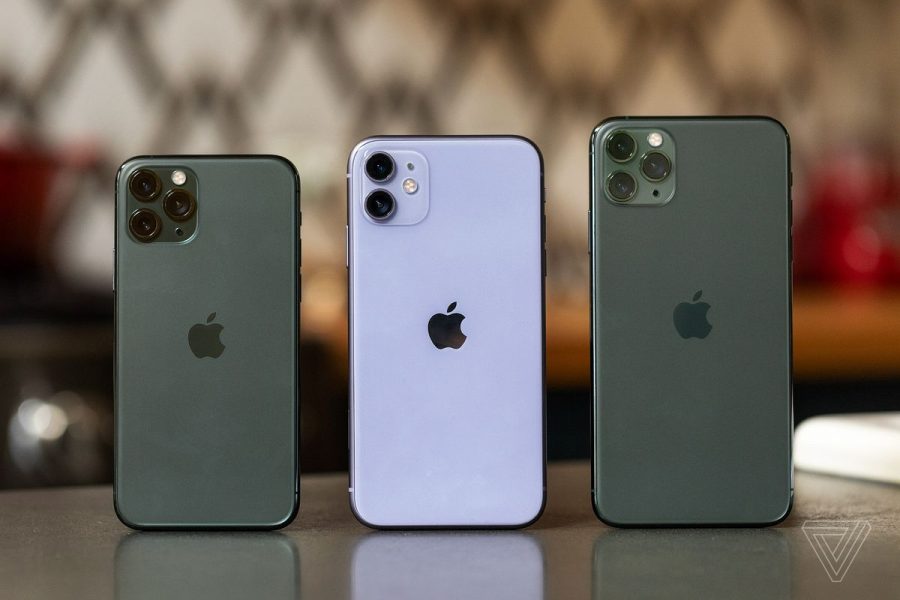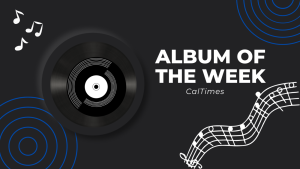Reviewing Apple’s latest: iPhone 11, Pro, & Pro Max
Amelia Holowaty Krales, The Verge
(From left to right), iPhone 11 Pro, iPhone 11, and iPhone 11 Pro Max
September 27, 2019
It’s essentially a ritual at this point. Every September, Apple announces a slew of new technology to the market from the Steve Jobs Theatre in Cupertino, California. This year, on September 10th, Apple announced not one, but three new iPhones. While rumors and leaks were a flurry in the months leading up to the event, most surprisingly accurate if not spot-on in terms of their content, many were skeptical as to whether or not the announcements would hold the same water as usual. To the surprise of many, though, Apple still brought the magic to an announcement that would normally be regarded as a wash, as the cats were already out of the bag.
Apple’s traditional schedule for iPhone releases was a two-year cycle, in which a new model was released and the subsequent year would be an “S” revision in which speed, performance, and overall usability was well polished and refined. More recently, though, this cycle has been moved to a three-year one, in which Apple will release three consecutive years of devices that are for the most part cosmetically similar, with key improvements each year. For instance, late 2017 marked the announcement and release of the iPhone X, Apple’s latest redesign of their iconic device. In 2018, the iPhone XS, XS Max, and XR were revealed, marking minor fixes and performance improvements to the “S” models, with the XR being a more affordable variant of the XS with notable differences, such as its 6.1 inch LCD display as opposed to the 5.8 and 6.5 inch OLEDs on the “S” variants.
In 2019, the three device variants announced by Apple were the iPhone 11, iPhone 11 Pro, and iPhone 11 Pro Max. While all three devices see big changes from last year’s versions, the aesthetics and sizes of the latter are here to stay, such as the everpopular “notch” that houses the front-facing camera and Face ID technologies.
The iPhone 11, poised by Apple as a better, faster version of the previous year’s XR, sports yet another LCD display with the updated A13 Bionic chipset and an extra camera lens, on top of its standard wide lens, for ultra-wide photography. According to Apple, its battery life will last one hour longer than last year’s XR, as well. Its price point is $50 cheaper than the XR, at $699 retail, in a suspected bid to appeal to the value device market that has seen success for manufacturers like Google, with its Pixel 3a device released early this year. The device will come in six colors, including white, black, red, green, yellow, and purple.
The iPhone 11 Pro and 11 Pro Max sport some even bigger changes. The devices, nearly identical besides display and body size, sport an additional ultra-wide camera lens in addition to last year’s standard wide angle and telephoto zoom lenses. Apple also revealed these camera improvements allow the ability to shoot up to 4K video. Additionally, like the standard iPhone 11, the two Pro variants will also see an upgrade from the A12 to A13 Bionic chipset and big battery upgrades. According to Apple, the iPhone 11 Pro will see a four-hour improvement in battery life over last year’s iPhone XS, and the iPhone 11 Pro will see a five-hour improvement over last year’s XS Max. In addition to these improvements, one interesting cosmetic change from Apple is the rollout of a “soft touch”, matte glass back on the device. The device will come in four colors, including space gray, silver, gold, and midnight green.
With the release of iOS 13, the overall user experience is also improved, especially on the new devices. Key features of the new operating system include better processing and batter management, system-wide dark mode, a swipe-able keyboard, “Sign in with Apple”, and more.
As an employee of a technology company, I was fortunate to receive a hands-on experience with the devices shortly before they went on sale, and, inevitably, sold out. I can definitely say that although these devices land in the third year of Apple’s brutal three-year device release cycle, they are a definite step up in a way that is more significant than the X to XS transition. In the hand, the Pro and Pro Max have a premium feel that is above and beyond that of last year’s XS variants. The soft-touch back compliments the stainless-steel frame that the device is built on, and has an infectious appeal that blows the glossy back of the XS out of the water. In appearance, the Pro and Pro Max look odd at first sight. Apple opted for a symmetrical, triangular format for the three camera modules in a glossy, square glass bump that is cut into the rest of the glass back. The look grew on me overtime, and fortunately looks much better than what many of the early leaks and renders indicated. The cameras are indeed excellent, especially for video. Apple’s photo processing is not at “Pixel-level”, in reference to the Google Pixel’s cameras so to speak, in terms of post-shot appearance, but is definitely some of the finest on the market. The iOS experience with iOS 13 adds great improvements to the simple, minimalistic, and already refined qualities of iOS as an operating system. As a person that frequents Android in addition to iOS, I can definitely say that the experience, overall, is a competitive improvement.
As for the standard iPhone 11, it’s the XR with an extra camera, but that’s not a bad thing. The iPhone XR was Apple’s best selling device of 2019, and this minor improvement will be sure to put the iPhone 11 on the same course, especially with it’s attractive price point.
All in all, the new iPhones are great devices. To the question of whether or not Apple is innovating rather than compromising, I would take the latter argument. But then again, this year was not meant to be a major cosmetic or functional change, but rather a final refinement to an already refined device series.
With that being said, I feel that current XS and XS Max owners need not upgrade. Like previously stated, the improvements made are great, but not enough to justify an additional phone purchase this year, in my opinion. Perhaps wait for the 2020 device revamp before considering a change. As for everyone else, give the updated cameras and refined user experience a shot. You’ll be getting your hands on the best Apple has to offer.







